Marshall Lev Dermer
with the Collaboration of Robert Lee Price
It’s February 2022 and amazingly I’m 76 years old! But some sixty years ago, during the 1950’s and 1960’s, I lived in East Rogers Park (now called Rogers Park), a neighborhood on the far northeast side of Chicago. We had moved there from Austin, a neighborhood to the southwest, so that my mother, a single-parent, could live close to her siblings.
Dr. Steinberg: Dental Surgeon
My mother didn’t know much about dental hygiene. So, I often spent my youth squirming in dental chairs listening to dental motors. The motor I most feared was Dr. Steinberg’s.
Steinberg’s office was located on the second floor of a brown-brick building on the southwest corner of Glenwood and Morse Avenues. Steinberg’s shingle, somewhat like a pirate’s flag, swung from a staff over the corner. Instead of a skull and crossed bones, in bold white letters the shingle displayed “STEINBERG.”
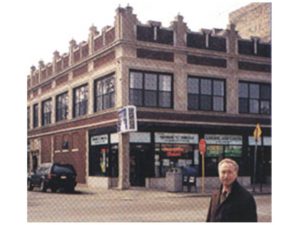
A steep flight of wooden stairs lead to the second-floor offices of Dr. Krakow (another story) and Dr. Steinberg. Steinberg was bald except for gray hair around the sides of his head. His face was wrinkled but he was slim, and his disposition was ever serious.
His 30 year-old chair was built in the 1920’s. The chair’s cold, iron frame, may have once been white. The places where the patient’s body contacted the chair were painted black, presumably to hide dirt.
Steinberg’s motor, unlike modern, rapid, air-powered devices, powered his drill through an assortment of pulleys and cords–all too slowly. My teeth have suffered many drillings since I left Steinberg’s chair but no motor was as slow as Steinberg’s.
I remember my last visit. Dr. Steinberg had packed my mouth with cotton and built a rubber dam around the tooth before commencing drilling. Steinberg never offered analgesics, so I felt as if he were pounding a red-hot nail into my tooth. Neither the gurgling of the water in Steinberg’s cuspidor nor the sounds of his saliva ejector hanging from my lower lip could distract me.
I suppose that Steinberg eventually noticed my suffering and cut the procedure short. Steinberg filled the cavity with a temporary, but I never revisited Steinberg’s office.
My cousin, Val Alpern, a dentist in Skokie, a suburb to the northwest, subsequently inspected Steinberg’s work and reported that Steinberg had used the “right” procedure. True, but he had lost the patient. In the future I dealt with Cousin Val. Public transportation from East Rogers Park to Skokie via the “Skokie 97” bus was time consuming, but Cousin Val was relatively painless.
Some 50 years later while living in Wisconsin, I had found myself thinking about Steinberg as I rode my bike along the parkway that follows the Milwaukee River. No, I wasn’t suffering a toothache.
As I pedaled I thought of Steinberg’s pedaling his bike. Throughout the year, Steinberg biked as well as played solo games of handball either behind the Eugene Field School or the Loyola Park Field House. As I rode my bike, I could easily see Steinberg with his sweatshirt and towel around his neck pedaling west on Lunt Avenue. I neither understood the value of dental hygiene nor regular exercise when I knew Dr. Steinberg. I do now.
Mitchell Jacobs: Registered Pharmacist
Mitchell Jacobs was born in Green Bay, Wisconsin and graduated from Marquette University. He was the proprietor of “Lunt-El Drugs,” a tiny, dark, dusty store beneath the elevated tracks on Lunt Avenue. I worked for “Mitch” from about my twelfth birthday until I was sixteen years old.
From the Eugene Field School’s student-run newspaper “The Field Message” is an advertisement for the drugstore, circa the 1960’s.
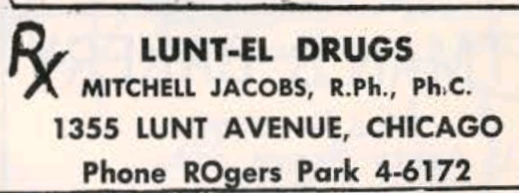
Below is a photo of the drugstore’s location.
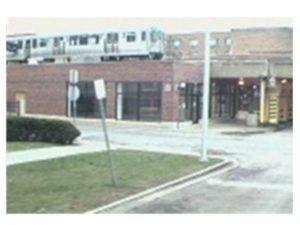
The work was educational. I learned, among other things, how to: interact with the public, make sodas, mop floors, make coffee, wrap packages, count change, the purpose of condoms and sanitary napkins, count in multiples of 27 (A pack of cigarettes cost just 27 cents!), and serve nickel Cokes as well as the ever popular glass of seltzer water.
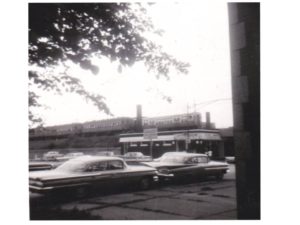
I would deliver: suppositories to little Mrs. Fishman who always offered a ten-cent tip; elixir terpin hydrate with codeine to Mr. Murphy who always offered a huge quarter tip; and cigarettes, cigars, and ice cream to people who did not reliably tip. I should note that Mr. Murphy frequently ordered codeine syrup perhaps for a recurrent “cough.”
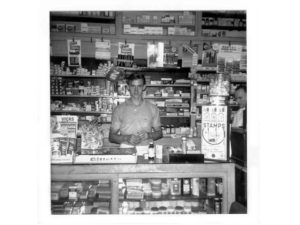
The soda fountain featured Sealtest Ice Cream (“Get the best; Get Sealtest!”); Mitch was always proud of the ice cream’s high butterfat content. I best remember the Mondae Sundae glasses. Their bottoms were tall and somewhat narrow like soda glasses whereas their tops opened wide like sundae glasses. The bottom, therefore, could be filled with a mixture of seltzer and chocolate syrup while the top could be filled with a huge scoop of ice cream covered with chocolate syrup or hot fudge, nuts, whipped cream, and a maraschino cherry. One would eat the top sundae portion until the ice cream fell to the glass’s bottom and formed an ice cream soda!
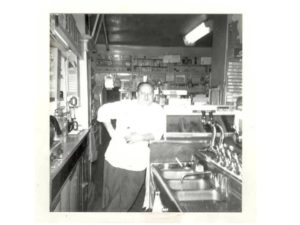
I’m afraid to think of all the fat I consumed at Lunt-El Drugs! On the other hand, because most of us didn’t know the relation between fat and cardiovascular disease we enjoyed every creamy spoonful.
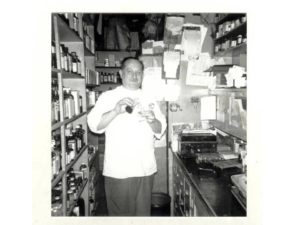
Kindly George Benson, Mitch’s assistant, taught me how to solder and how to mop a floor without first sweeping it! Everyone thought George was a pharmacist, but apparently he wasn’t. One day I arrived at work and learned that George was not returning. It seems that for years Mitch had helped George masquerade as a pharmacist!
Was Mitch paying George pharmacist wages? And what was Mitch paying his soda jerks? When I began working for Mitch, I earned about fifty cents per hour. I don’t recall his paying any young person the minimum wage. I remember his once complaining that I had not worked fast enough and I asked, “What do you want for sixty cents an hour?” He sternly told me that my remark would cost me several raises.
What about my covering for sick workers? Spraying the premises with insecticides to kill disgusting roaches? Delivering prescriptions during Chicago winters?
I was too young and naive to immediately seek employment elsewhere. When I was sixteen, however, I immediately began working for Walgreens. My pay jumped from about 65 cents per hour to the minimum wage, $1.25 per hour.
I kept the “conversation” with Mitch from my mother, a semi-skilled sewing machine operator, who looked forward to the day when she would earn $100 weekly. My mother had enough worries.
Though Mitchell Jacobs highly regarded himself, I didn’t for he routinely exploited his child employees.
Chris and Tina Kotsiakos
When I first met Chris and Tina Kotsiakos their grocery store was in our building at 1344 W. Lunt Avenue. When my mother and I had first moved into the building they had offered me a round, hand-sized blueberry pie. I would often buy little things there like the pies and Vernor’s ginger ale. My mother, however, was mostly concerned with price and so she shopped at Sure Save, a supermarket on the northeast corner of Morse and Glenwood Avenues.
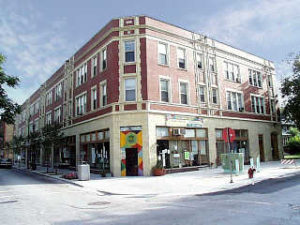
I didn’t have extensive conversations with Chris and Tina, but clearly they were hard working. When I met them they were probably in their late 50’s and their grown children sometimes helped them. I was struck by the entire family’s good looks.
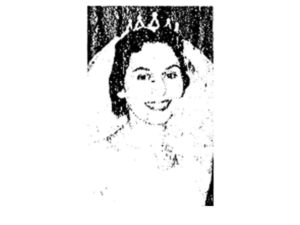
They eventually moved their store under the El directly west of Lunt-El Drugs. The new store was small but my impression was that it was busier for the location was ideal as everyone who exited the El at Lunt walked past the new store.
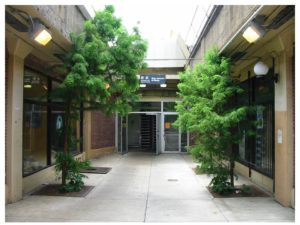
Via Facebook I found Chris and Tina’s grandson, Chris Kotsiopoulos who sent this remarkable photograph.
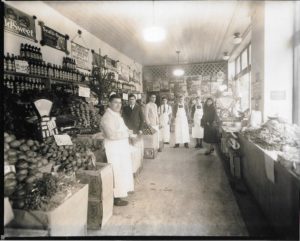
About Chris and Tina, my friend Bob Price wrote that one of his first jobs was stock work at their grocery store. Also Chris had bought a subscription to the Reader’s Digest magazine from Bob “a child starting out in life.” Bob recalls Chris selling ice-cold watermelon by the slice. Chris would retrieve the melon from the then vintage refrigerated cases in the back of the store and Bob, on hot days, would sit on the curb, by the store, gobbling up a slice.
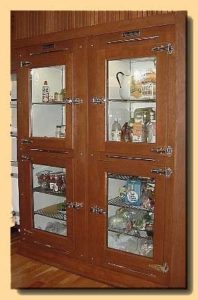
Louis and Sarah Arky
Louis and Sarah Arky owned Glenwood Cycle Shop which was located on the west side of Glenwood between Morse and Farwell Avenues. During the winter the Arkys would sell Nestor Johnson ice skates and Lionel trains which they displayed in their shop’s store-front window. I best remember that window at night, aglow with neon lights promoting Schwinn bicycles. In the summer, a bicycle might adorn that window along with “Louisville Slugger bats,” Wilson baseball gloves, and, of course, red box’s supporting “Clinchers,” the 16″ softballs that were so popular in neighborhood games.
I never formally worked for Louis AKA Arky; rather I would visit and schmooze with the family. We talked about the stock market, the importance of school, daily events, how my mother had a difficult life, and sometimes about their troublesome son Harry.
I often assembled bicycles there, including: Dunelts, Robin Hoods, Raleighs, and Schwinns. The latter bikes included: Hornets, Americans, Pixies, and the new bikes with deraileurs—the Varsity, Continental, and the Super Sport. Arky owned a pre-World War II Schwinn World and would, of course, often fantasize about Schwinn Paramounts.
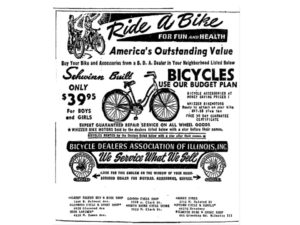
One summer, Arky enrolled me and Jack Zimmerman in Schwinn Bicycle School. For a week or so, Jack and I would pedal to the Schwinn plant on North Kostner Avenue for training. A week after the training was completed, Jack’s diploma arrived; mine did not. I had failed bicycle school.
In retrospect, I wasn’t surprised. Although I had done just about everything right, the instructor would often find extra parts on my bench and suspected that I had forgotten to include them in the assembly. If he would have asked, I could have disassembled my work and he could have seen that all my parts were in place. Instead, Jack had earned the diploma by putting his “extra” parts on my bench!
I enjoyed schmoozing with Arky. He often reminisced about working as a youth at a Liggett newspaper/food stand in St. Louis. Apparently, frozen orange juice had just been introduced and he sold it, but complained that it did not taste like fresh orange juice. Arky was much prouder of his work assembling aircraft during World War II.
Arky had a bad back and occasionally he would put on a brace but never complain about pain. I only came to appreciate this approach to back pain when I was in my 40s.
Recently, I discovered that Arky and Sarah are buried in Chicago’s Westlawn Cemetery. Indeed just by walking from grave to grave you can discover many former residents of East Rogers Park!
Mrs. Brady
At 7021 N. Glenwood, in the building in which mother and I lived, a doll hospital was run by Mrs. Brady. When I knew her, she may have been in her sixty’s. She wore glasses and pulled her grey hair back to form a bun. She was patient and spoke gently as befits a doll doctor.
There was nothing fancy about her hospital but she had the right tools, materials, and skills as there was often a steady stream of well-heeled people seeking “medical” attention for their “loved ones.”
Mrs. Brady had a companion–a Siamese cat with blue hypnotizing eyes. At the time, I was in 5th grade at the Eugene Field School and in my eyes Mrs. Brady was a pet expert.
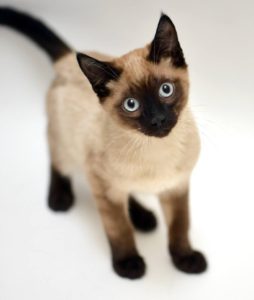
One day I told Mrs. Brady that I had a turtle. This little painted turtle I had purchased either from Charles Variety Store on Morse Avenue or from Kling’s Pet Shop on Clark Street. In either case, I had kept the turtle in a white porcelain drawer that had once been used as a vegetable crisper.SAt the middle of this drawer, I had built a little island from rocks that I probably had collected at the Lunt Avenue beach. I do know that I well fed that turtle much as my Jewish mother well fed me.
SSSI thought the turtle to be happy, but Mrs. Brady noted that the island was so low that the poor little turtle most often could only view the crisper’s white walls. She was right and so I piled more rocks on the island so the turtle, who I had doubtlessly named, would have a more stimulating view.
One very cold, blustery, winter day, I had been ice skating on the flooded field at the foot of Touhy Avenue and as I walked home I realized that I had not fed my turtle. So I sped up and I recall saying to myself, “that turtle doesn’t appreciate all that I do for it.” Decades later I recall my mother similalry complaining, “I gave you the best years of my life.”
Mr. Chambers
South of Mrs. Brady’s hospital was Mr. Chamber’s factory. With a round face and frequent smiles Mr. Chambers made scrapers, the kind used for removing wall paper or paint.
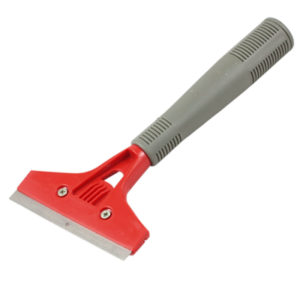
Above, I’ve included a scraper like those Mr. Chamber’s made. Mr. Chambers’ scrapers included a U-shapped handle made from thick aluminum wire. Except for the blade, Mr. Chambers fabricated all the components. He would cut the wire, bend it, crimp the ends, drill and tap holes for the two screws that held the blade holder, and cut extruded aluminium strips for the blade holders. He would mount the scrapers on cardboard so the scrapers could be displayed at hardware stores. I guess he boxed up the scrapers too. Mr. Chambers was industrious!
He also made impressive indoor fountains. I suspect they were custom ordered. At the heart of each fountain was a water pump.
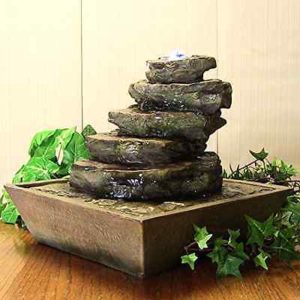
Inspired by Mr. Chamber’s work, I eventually came to put a pump to good use in a science fair project.
Mr. Cohen, Mrs. Garland, and Sam Wolberg: A Little About Hebrew School
At Congregation B’nai Zion, 1445 W Pratt Ave, I attended Hebrew school. Housed in the Wolberg Community Center, the school opened, in 1951, in a beautiful building financed with a $225,000 gift from Sam Wolberg. Of course, back then, what did I know about Sam Wolberg’s tzedakah (beneficence)?
I did know that each weekday, at about 3:15 PM, I was expected to walk four blocks from the Eugene Field School to Hebrew school, enter through the Greenview Avenue doors, and walk up a flight of stairs to class.
My mother expected me to be a very good student, but I was quite unmotivated. My biggest accomplishment over some three years of Hebrew school was learning to read Hebrew. In contrast, my biggest accomplishment over some two days of studying college Russian was learning to read Cyrillic.
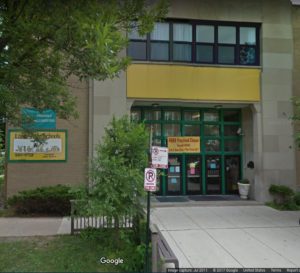
I most vividly recall classroom interruptions. Wearing a suit and tie, with a kippah covering his bald head and glasses correcting his vision, the principal, Mr. David Cohn, often interrupted class to confer with our gray-haired, conservatively dressed teacher, Mrs. Miriam Garland who also wore glasses. Cohen would signal Garland to leave the classroom. In the hallway, the two would chat in Hebrew.
How about respecting us? What could be so important? Were the topics taboo? Did I learn so little in school because of the many interruptions? Not!
Although Sam Wolberg paid for the construction of his namesake building, he missed an opportunity to teach Hebrew. You see Sam and his associates had founded Chicago Coin which manufactured pinball machines. For example, by the mid 1970’s Chicago Coin had reportedly sold some 8,800 Kilroy pinball tables. Indeed, Sam, looking to the future, had insisted, in a trade publication, that the coin-machine industry must expand and place machines in venues beyond arcades, taverns, and bowling alleys.
But when I was a student at B’nai Zion, no Kilroy was here! Too bad, because the machines could have kept score using Hebrew numerals. Hebrew numbering follows a decimal system with Arabic characters (1, 2, 3, . . . ) replaced with Hebrew characters ( א , ב , ג, . . .)!
For me, Hebrew school was at its worst in the winter. By mid-December, I would be entering school when the sun was up; and departing school when the sun was down. Sure, floodlights illuminated the Greenview exit. But returning home, to Lunt and Glenwood Avenues, often required plunging into a dark, cold mess.
When the weather was bad, I would check that my scarf well protected my neck, lean into the chilling wind, and begin walking while scanning the snow-covered sidewalks for slippery ice. Falling on one’s ass hurt but stepping off the curb into a slush-filled gutter was worse, for it meant walking in cold, wet shoes for blocks.
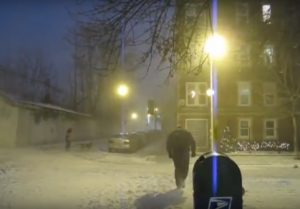
I would walk north on Greenview to Farwell, then to Morse, and then east on Morse past the neighborhood’s most famous delicatessen Ashkenaz and continued on to Froikin’s a much smaller, intimate delicatessen.
Mr. Froikin: Proprietor of Froikin’s (Kosher Style) Delicatessen
Unlike Mr. Froikin, the store was rather narrow. As you entered, to the right were shiny stainless steel, refrigerated cases. On them were loaves of rye bread and trays piled with 1/2 in thick potato latkes. Through the cases’ glass windows you could see gefilte fish, herring, cole slaw, chopped liver, knishes, and more. Behind the case was Mr. Froikin or one of his employees and behind them were long salamis (Vienna, Vilna) hanging from hooks attached to chrome, wall-mounted brackets.
As you entered, to the left, there were more stainless-steel cases. I best recall the cases that held quart bottles of Old Colony soda, particularly the black cherry soda. Also memorable was Nedlog brand (Golden spelled backwards.) orange drink. Further in the back were a few tables and chairs.
For some 50 cents you could buy a thick, hot corned beef sandwich on rye with mustard and a pickle. For ten cents you could buy a 5-in piece of hot kishke. On my budget, I most often bought the kishke.
Froikin’s kishke was savory and served hot. It was made from cow intestines, that had been stuffed with flour, matzo meal, grated carrots, schmaltz (beef fat), and savory spices. It has been some 60 years since I enjoyed a piece of Froikin’s kishke, yet my mouth is watering just writing about it! My piece was wrapped in wax paper and I enjoyed it as I walked home.
Bob Price kindly sent me a story about Froikin’s. One afternoon, Bob visited Froikin’s not to buy kishke but to sell Mr. Froikin fire extinguishers. Earlier, Bob had responded to a magazine advert about making a fortune selling Presto fire extinguishers. (I guess Bob had not earlier made a fortune selling Reader’s Digest.)
Bob reports that Mr. Froikin invited him into the kitchen where Bob demonstrated the extinguisher. Although the extinguisher filled the kitchen with a “delicious” aroma, Mr. Froikin seemed happy enough and so at the “tender age” of 17, Bob had made his first extinguisher sale!
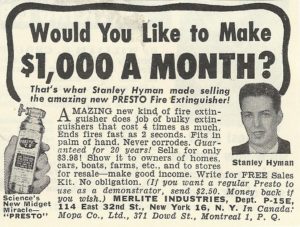
Was this the advert to which Bob had responded?
Sam Ashkenaz: Ashkenaz Restaurant & Deli
The center of interest in East Rogers Park, for non-obervant Jewish people, was doubtlessly “Ashkenaz” and its kosher-style food. I could write more but a wonderful history of Ashkenaz, written by Neil Gale, is on the WWW. I have stored that history at the Internet Archives here.
Bob Price certainly enjoyed Ashkenaz’s delicious food and learned a lesson as an employee. “I worked there at about age 16. I was the “fountain manager” along with a guy named Steve. Also I worked part time behind the front grill where I made “short order’ sandwiches. Henry, the manager, nice guy but a business man, asked me to cut pickles in thirds. Some pickles, however, I cut in halves as they were small. At one point Henry reprimanded me, “I asked you to cut them in thirds.” To this I responded with my adolescent voice, “big deal.” Henry said nothing but on payday, I received my earnings and walking papers. I had been fired. This is a lesson that I remember to this day: Don’t be a wise guy!“
(This is a work in progress. Please join me in contributing. marshall@dermer.com; Marshall 8/28/2018)